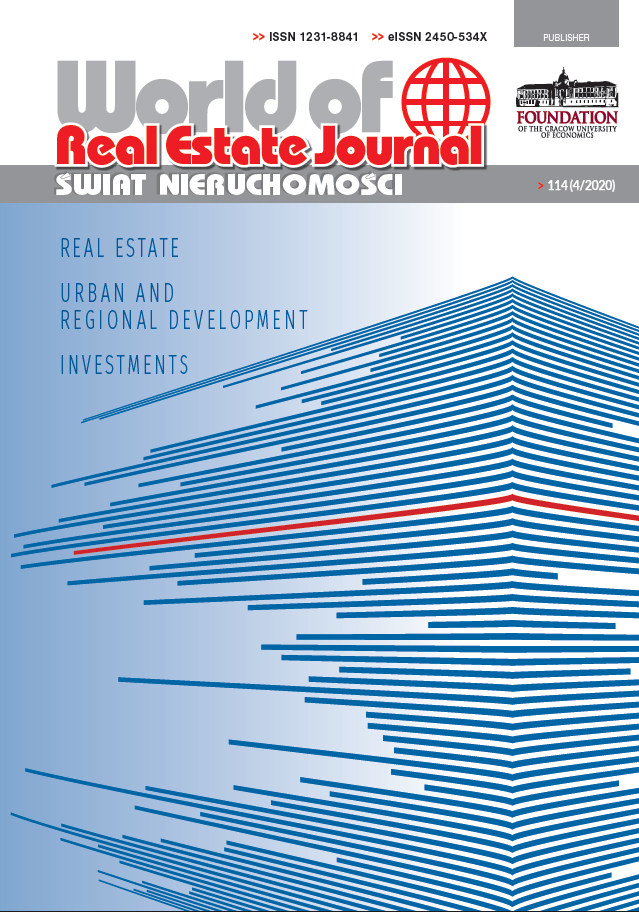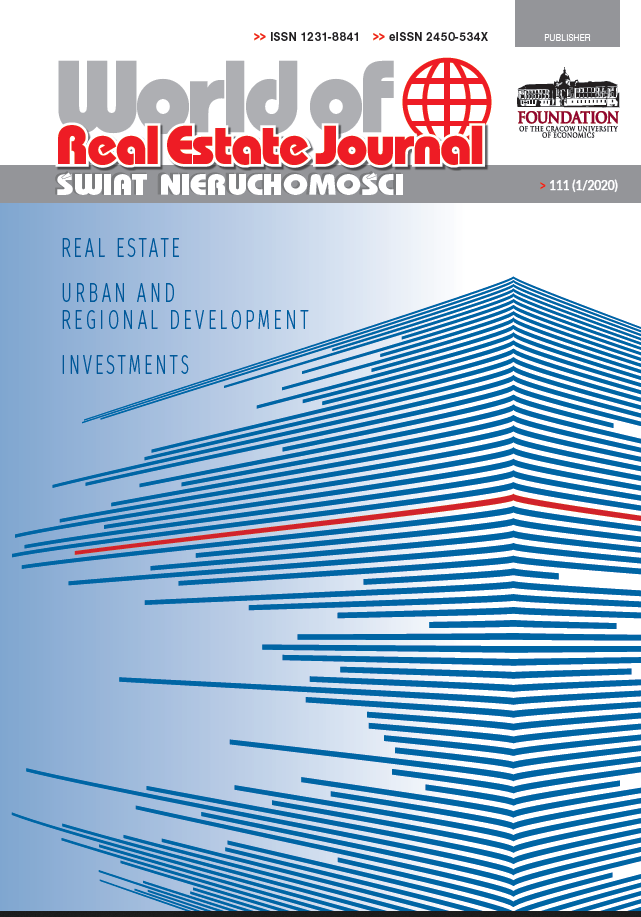FINANCE
1) Iwona Foryś, Mirosław Górski, Karolina Jarosz - Tendency of Business Entities to Utilize Lease for Real Estate Financing
HOUSING
2) Sebastian Biel - Causes, Types and Evaluation of the Diminished Value of Components as a Result of Construction Defects in Housing
SPATIAL DEVELOPMENT
3) Teodor Skotarczak - Impact of Regulations Concerning the Shaping of Agricultural System on Spatial Development
PROBLEMS OF URBAN DEVELOPMENT
4) Anna Stankowska - The Development of Housing Near the High Voltage Overhead Lines in Urban Areas
5) Sebastian Brańka - Assessment of Obstacles for Place Marketing
CONFERENCES
6) Michał Głuszak - 59th Congress of European Regional Science Association (ERSA) (France, Lyon 27-30 August, 2019) DOWNLOAD
7) Agnieszka Małkowska - 4th National Scientific Conference Finances -Statistics - Empirical Research (FINSTAT) (Poland, Wroclaw 23 October 2019) DOWNLOAD
SUMMARIES
Iwona Foryś, Mirosław Górski, Karolina Jarosz - Tendency of Business Entities to Utilize Lease for Real Estate Financing
Purpose: Real estate leasing is more and more often treated as an alternative way to raise funds for real estate acquisition. Despite the undoubted advantages it has, the development tendencies of this form of real estate financing should be assessed quite coolly.
Method: objective of the article is to present both barriers and elements stimulating the development of real estate leasing and to compare two forms of real estate financing: credit and leasing in Polish conditions.
Findings: The results of the conducted research on the real estate leasing show that despite significant economic development in Poland, the interest in real estate financing is of a marginal character. Due to synergistic effects of multiple determinants on an enterprise it is very hard to indicate which factors in particular influence the increase in trends in this area.
Research implications: The results of legal and tax analysis and simulation may lead real estate investors to consider an alternative form of financing. This can be a beneficial solution in case of poor credit rating.
Keywords: real estate financing, real estate Leasing, enterprise
JEL codes: H54, H71, K25
Category of the paper: research article
CITATION (APA): Foryś, I., Górski, M., & Jarosz, K. (2019). Tendency of business entities to utilize lease for real estate financing . World of Real Estate Journal, 109(3), 5-22.
DOI: https://doi.org/10.14659/worej.2019.109.01
READ ALL...
Sebastian Biel - Causes, Types and Evaluation of the Diminished Value of Components as a Result of Construction Defects in Housing
Purpose: The paper aims at indicating the main reasons of construction defects found during the acceptance of multifamily residential buildings and determine the diminished value of a defective component by means of the use value analysis.
Method:The author has shown the application of the Aurnhammer’s method to determine the diminished value of a component.
Findings: The defects found during the acceptance carried out by inspectors and by apartment buyers are very similar – mainly absence of right angles between walls, scratched window panes and window sills and uneven and scratched walls. Based on Aurnhammer’s method, it was estimated that the value of window joinery has diminished by 7.6% and the value of screed has diminished by 15.6%. The evaluation of diminished value can be done using a block diagram. The analysis indicated that the window value has diminished by 8% and internal plasters value has diminished by 13.75%. The limitation of research is the assessment of the real state of the element made visually on a subjective scale and possible errors in the cost calculation that inflate or underestimate the value of the evaluated element.
Research implications: The presented methods may be used during the acceptance of flats - they may assist the supervision inspector in deciding on the acceptance of the flat, as well as the contractor's representative, who during the acceptance of the flat can quickly estimate the diminished value of an element may have the defect detected during the acceptance of the flat.
Keywords: construction defects; Aurnhammer’s method; apartment acceptance; housing; developer
JEL codes: C83, R3
Category of the paper: research article
CITATION (APA): Biel, S. (2019). Causes, Types and Evaluation of the Diminished Value of Components as a Result of Construction Defects in Housing. World of Real Estate Journal, 109(3), 23-38.
DOI: https://doi.org/10.14659/worej.2019.109.02
READ ALL...
Teodor Skotarczak - Impact of Regulations Concerning the Shaping of Agricultural System on Spatial Development
Purpose: The aim of the study was to assess the impact of changes introduced in 2016 in the sale of agricultural properties on spatial order and trade in agricultural properties. In addition, the economic effects of introducing new regulations shaping the agricultural system were introduced into the legal order.
Method: The publication analyzes available scientific literature and legal acts. Transaction prices of agricultural real estate subject to sales contracts in the years 2016-2019 were analyzed. The scope of research covered all voivodeships of Poland.
Findings: The conclusion drawn from data referring to the prices of agricultural properties in the period covered by the study allows to assume that the effects of changes in regulations on trading in these properties in various voivodeships are not uniform for the whole country. Limitation of the research was unavailability of the trading volume along with a reference to the area of real estate being traded. In principle, the available data relate to transaction prices only.
Research implications: Conducted research allows to indicate the relationship between spatial planning and agricultural policy and to show that they are interdependent not only on rural areas.
Keywords: agricultural system, spatial planning, agricultural property, restrictions on property rights
JEL codes: K11, R3
Category of the paper: research article
CITATION (APA): Skotarczak, T. (2019). Impact of Regulations Concerning the Shaping of Agricultural System on Spatial Development. World of Real Estate Journal, 109(3), 39-58.
DOI: https://doi.org/10.14659/worej.2019.109.03
READ ALL...
Anna Stankowska - The Development of Housing Near the High Voltage Overhead Lines in Urban Areas
Purpose: The progressing urbanization of cities makes it necessary to develop larger areas of land for housing development both in urban areas and on outskirts of cities. This often results in housing developments inevitably approaching high-voltage power lines built several years ago.
The purpose of this article is an overview of the guidelines in force in Poland and selected countries around the world regarding the possibilities of housing development in the vicinity of high-voltage power lines, whose presence is accompanied by electromagnetic fields. Also presented are international recommendations in this field. In addition, calculated values of magnetic field strength from a typical 400 kV overhead line in Poland as a function of distance from residential buildings are discussed.
Method: a systematic review and theoretical modelling of electromagnetic field distributions.
Findings: Based on the research, the author confirmed the research hypothesis, that there are not international norms and guidelines regulating the distance between power lines and residential development.
Research implications: The presented research is part of research on the power infrastructure in the economic, social and environmental aspect
Keywords: residential buildings, high voltage transmission lines
JEL codes: A120
Category of the paper: research article
CITATION (APA): Stankowska, A. (2019). The Development of Housing Near the High Voltage Overhead Lines in Urban Areas. World of Real Estate Journal, 109(3), 59-72.
DOI: https://doi.org/10.14659/worej.2019.109.04
READ ALL...
Sebastian Brańka - Assessment of Obstacles for Place Marketing. Lessons from an Exploratory Study among Place Marketing Practitioners in a Suburban Area of a Big City
Purpose: To fill the knowledge gap referring to identification of obstacles for place marketing, in particular in rural areas and in smaller towns.
Methods: Exploratory research among practitioners of place marketing with the use of in-depth interviews was conducted. Totally 14 interviews were conducted in 14 communes, in which participated a total number of 24 people. The indicated communes form the institutionalized functional area of the city of Cracow.
Findings: The field research and the comparative analysis with the results of former research projects allowed for identification of place marketing obstacles, specific for the population of rural areas and small towns. The budget limitations occurred to be the most frequently indicated obstacle both in researched suburban rural area and the cities from the previous research. The other obstacles differed between cities and rural areas. The research covered the suburban rural area around Cracow – the second biggest city in Poland. Therefore it must not be generalized to the general population of all rural areas in Poland. However one may assume that some similarities are very much likely in suburban areas of other big cities in Poland / Central Europe.
Research implications: The research provides one of the first insights into perception of place marketing obstacles among practicioners from rural areas. The results are a good starting point for the future research including e.g. conducting quantitative research among rural areas.
Keywords: place marketing, obstacles in place marketing, rural areas; quantitative research
JEL codes: R58, M31
Category of the paper: research article
CITATION (APA): Brańka, S. (2019). Assessment of Obstacles for Place Marketing. Lessons from an Exploratory Study among Place Marketing Practitioners in a Suburban Area of a Big City. World of Real Estate Journal, 109(3), 73-85.
DOI: https://doi.org/10.14659/worej.2019.109.05
READ ALL...
























































